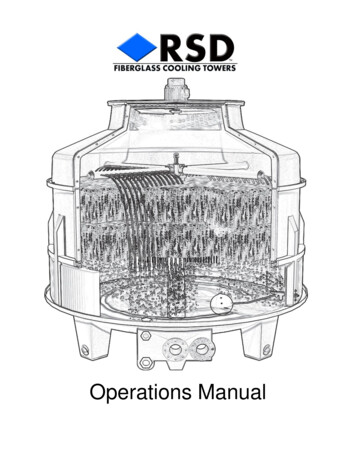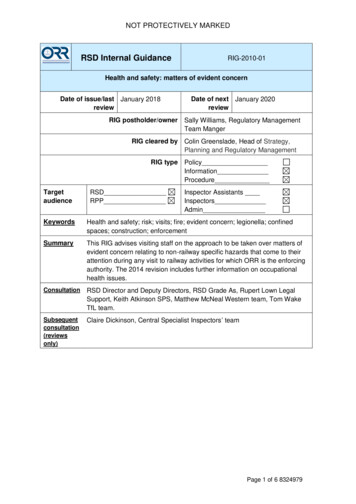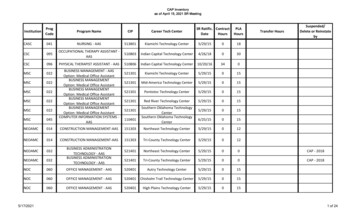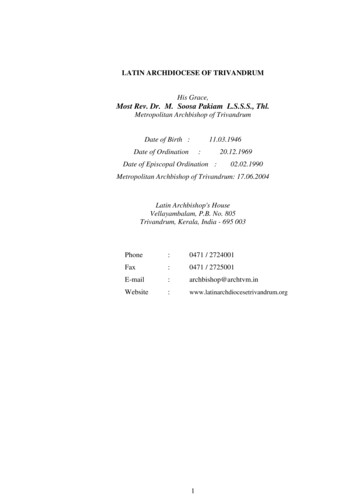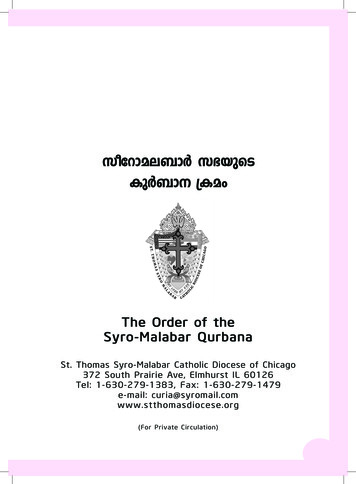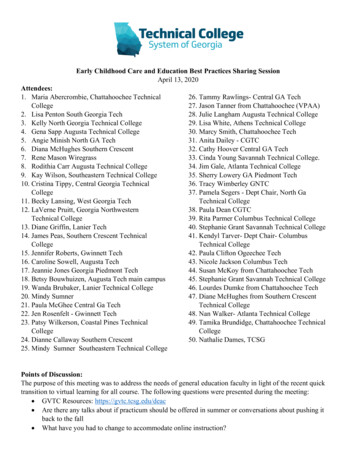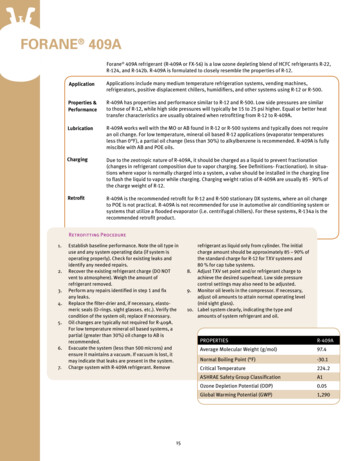
Transcription
FORANE 409AForane 409A refrigerant (R-409A or FX-56) is a low ozone depleting blend of HCFC refrigerants R-22,R-124, and R-142b. R-409A is formulated to closely resemble the properties of R-12.ApplicationApplications include many medium temperature refrigeration systems, vending machines,refrigerators, positive displacement chillers, humidifiers, and other systems using R-12 or R-500.Properties &PerformanceR-409A has properties and performance similar to R-12 and R-500. Low side pressures are similarto those of R-12, while high side pressures will typically be 15 to 25 psi higher. Equal or better heattransfer characteristics are usually obtained when retrofitting from R-12 to R-409A.LubricationR-409A works well with the MO or AB found in R-12 or R-500 systems and typically does not requirean oil change. For low temperature, mineral oil based R-12 applications (evaporator temperaturesless than 0 F), a partial oil change (less than 30%) to alkylbenzene is recommended. R-409A is fullymiscible with AB and POE oils.ChargingDue to the zeotropic nature of R-409A, it should be charged as a liquid to prevent fractionation(changes in refrigerant composition due to vapor charging. See Definitions- Fractionation). In situations where vapor is normally charged into a system, a valve should be installed in the charging lineto flash the liquid to vapor while charging. Charging weight ratios of R-409A are usually 85 - 90% ofthe charge weight of R-12.RetrofitR-409A is the recommended retrofit for R-12 and R-500 stationary DX systems, where an oil changeto POE is not practical. R-409A is not recommended for use in automotive air conditioning system orsystems that utilize a flooded evaporator (i.e. centrifugal chillers). For these systems, R-134a is therecommended retrofit product.Retrofitting Procedure1.2.3.4.5.6.7.Establish baseline performance. Note the oil type inuse and any system operating data (if system isoperating properly). Check for existing leaks andidentify any needed repairs.Recover the existing refrigerant charge (DO NOTvent to atmosphere). Weigh the amount ofrefrigerant removed.Perform any repairs identified in step 1 and fixany leaks.Replace the filter-drier and, if necessary, elastomeric seals (O-rings. sight glasses. etc.). Verify thecondition of the system oil; replace if necessary.Oil changes are typically not required for R-409A.For low temperature mineral oil based systems, apartial (greater than 30%) oil change to AB isrecommended.Evacuate the system (less than 500 microns) andensure it maintains a vacuum. If vacuum is lost, itmay indicate that leaks are present in the system.Charge system with R-409A refrigerant. Remove15refrigerant as liquid only from cylinder. The initialcharge amount should be approximately 85 – 90% ofthe standard charge for R-12 for TXV systems and80 % for cap tube systems.8. Adjust TXV set point and/or refrigerant charge toachieve the desired superheat. Low side pressurecontrol settings may also need to be adjusted.9. Monitor oil levels in the compressor. If necessary,adjust oil amounts to attain normal operating level(mid sight glass).10. Label system clearly, indicating the type andamounts of system refrigerant and oil.PROPERTIESR-409AAverage Molecular Weight (g/mol)97.4Normal Boiling Point ( F)-30.1Critical Temperature224.2ASHRAE Safety Group ClassificationA1Ozone Depletion Potential (ODP)0.05Global Warming Potential (GWP)1,290
R-22 TransitionMontreal ProtocolR-22 is the most widely used HCFC refrigerant for HVACRapplications, such as residential air conditioning, refrigeration, and other cooling applications. Although R-22 hasbeen a good solution for many different applications, it isclassified as an HCFC and is subject to phase-out accordingto the Montreal Protocol international treaty and the CleanAir Act in the United States.In the USA, the Clean Air Act has met the requirements ofthe Montreal Protocol by limiting consumption of HCFC,including R-22, through a series of phase downs through2030. Each step reduces R-22 consumption by reducing oreliminating R-22 in different market segments.As part of this phase down, R-22 will not be permitted foruse in new OEM HVACR equipment in 2010, reducing theR-22 demands into this sector and helping to meet the 75%reduction in ozone depleting substances.16In 2015, R-22 will have another step change reduction of90% of the overall allowable consumption for servicingR-22 systems in the United States.These step-downs will continue through 2030, when R-22will be completely phased out in the United States.In the USA, these regulations may change in the future.Please visit www.forane-us.com.R-22 users should be aware of the need to transition toother, more sustainable refrigerants meeting the application’s requirements. Current HFC refrigerants listed inthis Tech Digest meet these needs and are not under anyphase-out restrictions.
DefinitionsBubble Point (SaturatedLiquid Temperature)The temperature (for a given pressure) at which the liquid of a refrigerant blend (any 400 or 500 series refrigerant) begins toevaporate or boil. This is similar to the saturated liquid temperature of a single component refrigerant.Dew Point (SaturatedVapor Temperature)The temperature (for a given pressure) at which the vapor of a given refrigerant blend (any 400 or 500 series refrigerant) beginsto condense or liquefy. This is similar to the saturated vapor temperature of a single component refrigerant.FractionationThe change in composition of a refrigerant blend (any 400 or 500 series refrigerant) when it changes phase from liquid to vapor(evaporation) or from vapor to liquid (condensation). This behavior in blends explains the permanent changes to refrigerantcomposition from leaks, causing the blend to deviate outside the tolerances of the designed composition.GlideNormal Boiling Point (NBP)AbbreviationsThe difference in temperature between the evaporator outlet and inlet due to fractionation of the blend. Theoretically, this canbe calculated by finding the difference between the dew and bubble temperatures at constant pressure. Actual measurementsmay differ slightly depending on the state of the liquid refrigerant at either end of the evaporator (or condenser). Pressure lossesthrough the evaporator may also affect glide.The temperature at which a given refrigerant begins to boil while at atmospheric pressure (14.7 psia).AB – alkylbenzeneGWP – global warming potentialMO – mineral oilODP – ozone depletion potentialOEM – original equipment manufacturerPOE – polyolesterPAG – polyakylene glycolOther TopicsRefrigerant LubricantsThe phase-out of ozone depleting refrigerants has impacted air-conditioning and refrigeration equipment design in many ways.One of the most significant changes to these systems is the transition of the compressor lubricants. Use of an appropriatelubricant is important when servicing, installing, or retrofitting a system. The following information may be helpful as generalbackground information on refrigerant lubricants; however, always follow OEM recommendations for proper lubricant selection.Mineral Oil: Mineral oil has been the lubricant of choice for systems utilizing many of the CFC and HCFC refrigerants. Both theCFCs and HCFCs tend to have adequate miscibility with mineral oil, helping to ensure acceptable oil return under normal operatingconditions. Sometimes a synthetic lubricant (i.e. AB or POE) is required under certain conditions, such as reduced miscibility withCFC retrofit blends or high discharge temperatures with products like R-22.Alkylbenzene: Alkylbenzene is a synthetic refrigerant compressor lubricant used in new refrigeration systems and for retrofitsfrom CFCs to HCFCs. Typically, Alkylbenzene has better miscibility with HCFCs than mineral oil, resulting in more reliable oil return.For retrofits of older CFC equipment, a partial oil change from mineral oil to alkylbenzene may be acceptable.Polyolester: HFC refrigerants serve as the replacements for the ozone-depleting CFCs and HCFCs. However, both mineral oil andalkylbenzene have poor miscibility with HFCs, making oil return with these products unreliable in many systems. POEs are synthetic oils commonly used in new HFC systems and for retrofitting older CFC and HCFC equipment to HFC refrigerants. Special caremust be taken when using POE oils due to their quick absorption of moisture when left exposed to the atmosphere (hygroscopic).Polyalkylene Glycol: In addition to POE oils, polyalkylene glycol (PAG) lubricants are used with R-134a in automotive airconditioning applications. Like POEs, PAGs are hygroscopic synthetic oils and must be treated with care to minimize exposure tomoisture. While both POEs and PAGs are used with R-134a in automotive systems, the two oil types are not interchangeable andshould not be mixed.Material CompatibilityLeak DetectionWhenever retrofitting an air-conditioning or refrigeration system, compatibility of system materials is always a concern. Itemssuch as elastomers, hoses, and filter-driers respond differently to different refrigerants and oils. For these reasons, beforeperforming any refrigerant retrofit, Arkema recommends contacting the OEM for specific recommendations. Arkema’s TechnicalService hotline can also be reached at (800) 738-7695.Leak checking should be a routine practice whenever performing maintenance on or servicing an air-conditioning or refrigerationsystem. As elastomers and other sealing components may react differently to new refrigerants and oils, leak checking shouldalways be performed after any refrigerant retrofit.Certain older style leak detectors have difficulty detecting newer refrigerants. It is important to verify whether or not your leakdetector is rated for the type of refrigerant (CFC, HCFC, or HFC) you will be working with. Also, some refrigerant dyes are onlycompatible with specific refrigerant oils. Always check with the manufacturer before using a leak dye in an air-conditioning orrefrigeration system.1717
Forane Refrigerant Pressure Temperature ChartPRESSURE (PSIG)Sat.Temp( essureR-401BVaporPressureSat.Temp( .2302.6279.365.6Red Numerals (in bold and italics) - Inches Hg. Below 1 ATM18
Forane Refrigerant Cylinder IdentificationPRESSURE (PSIG)Sat.Temp( F)R-502-50-45Sat.Temp( C)TypeSizes (Net lbs.)Color .10.61.1-45.61.91.14.93.22.73.3-42.8R-22HCFC Light Green30 (B), 50 (C), 125 (D), 1000, 1750HCFC Light Blue Grey100 (E), 200 (E)R-12CFCWhite30 (B), 50 (C), 145 (D), 2000R-502CFCLavender30 (B), 125 7.68.3-37.2R-401A HCFC Pinkish Red30 (B), 125 (D)-309.28.213.411.110.411.2-34.4R-401B30 (B), 125 (D)-2512.111.016.714.213.414.3-31.7R-402A HCFC Sand27 (B), 110 (D)-2015.314.120.417.616.817.8-28.9R-402B HCFC Olive13 (B)-1518.817.524.521.420.521.6-26.1R-408A HCFC Medium Purple24 (B), 100 (D), 1300-1022.621.228.825.424.525.7-23.3R-409A HCFC Tan30 (B), 125 (D), 1800Light Blue30 (B), 125 (D), 1000, 1750HCFC 9.538.734.633.534.9-17.8R-404A HFCOrange24 (B), 100 (D), 1300 tons535.934.244.239.838.640.2-15.0R-407A HFCLime Green25 (B), 115 (D)1041.039.350.145.344.045.8-12.2R-407CHFCBrown25 (B), 115 (D), 1000, 16001546.544.856.551.349.951.8-9.4R-427AHFCGreen25 (B) 110 (D)2052.550.763.457.656.258.3-6.7R-410AHFCRose25 (B), 100 (D), 850, 1350R-507AHFCTeal25 (B), 100 (D), 800, .47.2Container Types5097.495.8115.4106.3104.7108.110.0Size not to 50408.4423.0482.3450.0454.4468.165.6Red Numerals (in bold and italics) - Inches Hg. Below 1 ATM13/24/2527/30 lb.(B)100110115/125145 lb.(D)1950 lb.(C)100/200650/690 lb.Drum(E)
Forane Refrigerant Basic Property Data AR-507AR-22R-408AR-409AR-123Average Molecular Weight 2.9Normal Boiling Point (NBP) ( .182.1Latent Heat of Vaporization at NBP 4.673.7Critical Temp ( .2362.7Critical Pressure 5667.2532.9Density of Saturated Vapor @ NBP (lb/ft ity of Saturated Liquid at 77 F (lb/ft fic Heat of Saturated Vapor at NBP (BTU/lb ific Heat of Saturated Liquid at 77 F (BTU/lb ne Depletion Potential (ODP) (CFC-11 1Occupational Exposure Limits (8 hr time/wt. Avg.) 1,00050Global Warming Potential 1,29077ASHRAE Safety Group ClassificationThe information contained in this document is based on trials carried out by Arkema Research Centers and data selected from literature, but shall in no event be held to constitute or imply any warranty, undertaking, express or implied commitment from our part. Our formal specifications define the limit of our commitment. No liability whatsoever canbe accepted by Arkema with regard to the handling, processing or use of the product or products concerned which must in all cases be employed in accordance with all relevantlaws and/or regulations in force in the country or countries concerned.The statements, technical information and recommendations contained herein are believed to be accurate as of the date hereof. Since the conditions and methods of use of theproduct and of the information referred to herein are beyond our control, Arkema expressly disclaims any and all liability as to any results obtained or arising from any use of theproduct or reliance on such information; NO WARRANTY OF FITNESS FOR ANY PARTICULAR PURPOSE, WARRANTY OF MERCHANTABILITY OR ANY OTHER WARRANTY, EXPRESSOR IMPLIED, IS MADE CONCERNING THE GOODS DESCRIBED OR THE INFORMATION PROVIDED HEREIN. The information provided herein relates only to the specific productdesignated and may not be applicable when such product is used in combination with other materials or in any process. The user should thoroughly test any application beforecommercialization. Nothing contained herein constitutes a license to practice under any patent and it should not be construed as an inducement to infringe any patent and theuser is advised to take appropriate steps to be sure that any proposed use of the product will not result in patent infringement.Arkema Inc.2000 Market StreetPhiladelphia, PA 19103-3222Tel.: 215-419-7000www.arkema-inc.comADV-07 PPC-09/09See MSDS for Health & Safety ConsiderationsForane is a registered trademark belonging to Arkema 2009 Arkema Inc. All rights reserved.
FORANE 409A Forane 409A refrigerant (R-409A or FX-56) is a low ozone depleting blend of HCFC refrigerants R-22, R-124, and R-142b. R-409A is formulated to closely resemble the properties of R-12. Applications include many medium temperature refrigeration systems, vending machines,
